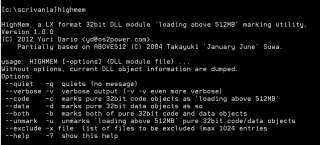Utilità che permette di marcare le librerie perché siano caricate in "memoria alta"!
HighMem
Categorie:
Licenza:
- Apache
Interfaccia:
- Finestra comandi
Installazione con rpm
Questo programma si può installare usando il gestore pacchetti rpm. Vedi sotto per la stringa di installazione. I prerequisiti richiesti sono gestiti dal gestore pacchetti e, se necessario, scaricati e installati automaticamente.
- installa con ANPM o lanciando il comando:
yum install highmem
- scarica manualmente come pacchetto ZIP:
http://rpm.netlabs.org/release/00/zip/highmem-1_0_3-1_oc00.zip
- installa con ANPM o lanciando il comando:
yum install highmem-debuginfo
Installazione manuale
Il programma è distribuito come pacchetto ZIP: scaricare in una cartella temporanea e scompattare nella cartella di destinazione, preferibilmente in PATH.
Le diverse opzioni del programma sono:
- caricare in memoria alta il codice
- caricare in memoria alta i dati
- caricare in memoria alta sia il codice che i dati
Citando Lars Erdmann (http://www.os2world.com/forum/index.php?topic=1466.msg14540#msg14540 ):
"Loading code high should almost always be ok. That's because loading code high is mostly transparent to applications: it's the kernel's job to map high addresses to the physical memory where the code resides. Unless some code tries to map a linear code address (aka: a function pointer) to a segmented code address, see below but that does not happen very often.
For loading data high this is much more critical: of course, the same applies as for code but remember "thunking"? A lot of APIs make the silent assumption that a linear data address can be easily mapped to a segmented address and vice versa by a simple well known "thunking" algorithm. However that algorithm only works for "low memory". And OS/2 has enough 16-bit code in its bowels that can only access data via a segmented data address. If you have a big application like Firefox you never know if there is some low level OS component that makes that simple assumption, thunks a data address and subsequently gets it wrong if "high memory" data addresses are used."

This work is licensed under a Creative Commons Attribution 4.0 International License.


Aggiungi un commento